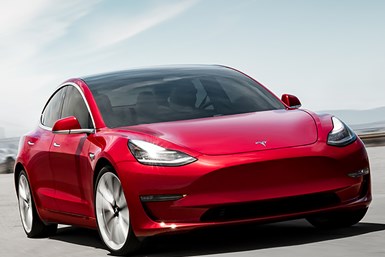Is Tesla on the Verge of an EV Battery Breakthrough?
Million-mile battery could debut by year-end
#hybrid
Tesla has long been hinting at a new low-cost, long-lasting battery that will make electric vehicles a viable mainstream alternative to conventional cars.
Now the teasing campaign may soon turn into real-world applications. Tesla is expected to announce details about the program (reportedly codenamed project Roadrunner) during a “Battery Day” presentation later this month.
More importantly, the technology could be introduced in a production vehicle by year-end.
What is It?
Last year Tesla, in conjunction with researchers at Canada’s Dalhousie University, patented a design for an optimized lithium-ion chemistry.
During testing, Dalhousie has shown such a battery can power an EV for more than 1 million miles. That would be more than twice the life of most current EV batteries.
The Dalhousie team, which is led by physicist Jeff Dahn, updated their findings in a study published in a recent issue of the Journal of the Electrochemical Society. The improved design greatly reduces the use of cobalt (the most expensive material in lithium-ion batteries) and boosts energy density.
China Partner
Tesla also is working with China-based CATL (Contemporary Amperex Technology Co. Ltd.) to refine and commercialize the technology, including a lithium-iron-phosphate design that eliminates cobalt altogether.

Tesla Model 3 (Image: Tesla)
The new battery will debut late this year or in early 2021 in the Chinese market Model 3 sedan, sources tell Reuters. Tesla began local production of the EV—with current nickel-cobalt-aluminum batteries supplied by Panasonic and LG Chem—at its new Shanghai factory late last year.
Applications in other Tesla models and other markets will follow sometime later next year, according to the report.
Why it’s Important
The new design, coupled with manufacturing improvements CATL is developing, could cut battery costs to less than $80/kWh.
Currently, the auto industry is working to reduce battery costs to $100/kWh. At that level, industry experts estimate, the cost of EVs would be on par with gasoline engine-powered vehicles.
The new low-cobalt battery being developed by General Motors and LG Chem isn’t expected to achieve $100/kWh until about mid-decade.
More Benefits
In addition to EVs, Tesla plans to use the new technology in its Powerwall home battery backup systems. The Powerwall units are produced alongside car batteries at the Reno, Nev., “Gigafactory” that Tesla operates with Panasonic.
Cars equipped with the batteries also could be connected directly to the grid to help power homes or allow consumers to sell excess energy back to utility companies. Other carmakers are pursuing similar strategies.
Further benefits could be derived by teaming batteries with ultracapacitors developed by Maxwell Technologies, which Tesla acquired last year. The carmaker also bought Hibar Systems, an Ontario-based battery company last September and is enhancing recycling capabilities through its Redwood Materials affiliate.
It’s all part of Tesla’s plan to eventually produce its own battery cells. CEO Elon Musk says this is essential to reducing costs and ensuring the company can meet increasing EV sales targets.
“We've got to scale battery production to crazy levels that people cannot even fathom today,” Musk told investors in January.
Breakthrough Competition
The race to develop a better battery is advancing at a breakneck pace, with new chemistries and other potential breakthroughs announced weekly.
IBM also is developing a cobalt-free battery. But the company, which is working with Mercedes-Benz on the technology, doesn’t expect to have a working prototype ready for about a year.
Most carmakers are focusing on solid-state systems, which promise significantly increased driving range and faster charging. Toyota and EV startup Fisker appear to be the furthest along, but even they don’t expect the technology to be production-ready for several years.
If Tesla is able to launch a significantly improved battery this year, it would be a huge competitive advantage that could keep the company in the EV driver’s seat for years to come.
RELATED CONTENT
-
When Automated Production Turning is the Low-Cost Option
For the right parts, or families of parts, an automated CNC turning cell is simply the least expensive way to produce high-quality parts. Here’s why.
-
Ford Copies Nature
As Nature (yes, capital N Nature) has done a pretty good job of designing things, it is somewhat surprising that Man (ditto) doesn’t follow Nature’s lead more often when it comes to designing objects.
-
Jeeps Modified for Moab
On Easter morning in Moab, Utah, when the population of that exceedingly-hard-to-get-to town in one of the most beautiful settings on Earth has more than doubled, some people won’t be hunting for Easter eggs, but will be trying to get a good look at one of the vehicles six that Jeep has prepared for real-life, fast-feedback from the assembled at the annual Easter Jeep Safari.









